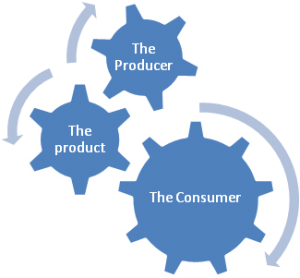Understanding Kano Analysis
Introduction
Products have to be consumer centric. The manufacturers of any product must have a clear idea of what purpose their product is promising to serve. In other words, a clear-cut definition of the functionality of the product is very important. A pudding is good only if the person who is eating approves it (in other words, the test of a pudding lies in its taste!)
Kano Analysis
Kano Analysis, as proposed by Noriaki Kano, a noted Japanese Researcher focuses on how to improve quality by addressing needs of a consumer. A lot of emphasis is placed on Quality assurance, Statistical Quality Control, Total Quality Management and a host of other production-improvement techniques. Sometimes, in the mechanics of production feasibility, the needs of the consumer are sidelined. Ideally, the producers make products to be sold to the final consumer as shown in the below ‘gear’ figure. All the steps are interlinked. The Kano analysis works backward, and suggests that the consumer’s needs should be assessed first and then the product should be fine tuned for improving performance.
In this context, it is important to think on the following lines:
1. What are the needs of your consumers?
2. How is your product’s functionality serving that need?
3. Are the consumers satisfied with the product that you offer? What is the level of satisfaction and dissatisfaction, if any, and what are the associated causes?
4. Are there ways by which you can increase consumer satisfaction?
5. Is it possible to classify product features and how each, or a group of them, serve consumer needs?
6. Is it possible to eliminate any unnecessary features (and also reduce cost) without compromising the functionality of the product?
How do consumers evaluate a product/service?
According to the Kano Analysis, it is important to understand what your consumer wants and then relate his wants to what your product can offer. This can help you work out a feasible strategy for segmenting, targeting and positioning of your products. Ideally, consumer preferences can be divided into many categories, but for practical purposes we will take a look at the three basic sub-sets.
1. Basic Needs (Also referred as ‘Must Haves’): A product must serve its basic purpose. A blender must blend well. A muffin must taste good. A high definition TV must have excellent picture quality. A consumer expects that the product will serve its basic function; he will mention that his car is great, but may not always mention that the choke plug, tires, battery and spark plugs are good too. He would notice that his refrigerator is very nice, but he may not always mention the thermostat, the door seal, the crisper cover, the door switch or the light. According to Kano’s analysis, there are product features which are absolutely essential for overall product performance, but looking from the consumer’s perspective they should just work well. There is no need to add extra cost to enhance these features, as a consumer would not be able to tell the difference. His level of satisfaction will not increase/decrease if you increase the cost of such features (For him ‘they should just work!!’).
2. Performance Needs (Also referred as ‘More the Better’): A consumer expects his product to perform well and this is imperative for satisfying his need. If he is unhappy with the performance of the product, he may never purchase it again.
3. Premium Needs (Also referred as the ‘excitement features’): Often we hear people saying,” Wow! I did not know that this device has such cool features’ Features that totally excite a consumer and give them an additional value for the price that they have paid are addressed by Kano’s Model as ‘Excitement features/Attractive features’. It is observed that ‘buy one get free offers’ are very popular in consumer products and excite buyers a lot. Many hotels offer coupons for free rides and other incentives which attract the potential tourists.
Conclusion: It is clear that Kano’s Analysis offers concrete pointers about how the product is perceived by a consumer, what he values most and what he does not care about so much. All that is needed is to ‘explode’ the product and relate it to how best the consumers needs are being met, how best can the consumer needs to be met potentially and how best can cost be reduced without compromising the satisfaction level of the consumer.
To learn more about Six Sigma or Lean practices, go to www.6Sigma.us to learn more about our training solutions.
Learn more
SixSigma.us offers both Live Virtual classes as well as Online Self-Paced training. Most option includes access to the same great Master Black Belt instructors that teach our World Class in-person sessions. Sign-up today!
Virtual Classroom Training Programs Self-Paced Online Training Programs







